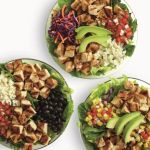
How Fast Food Restaurants Are Adapting Menus to Include Healthier Alternatives
- 1- The Growing Demand for Healthier Fast Food
- 2- What Healthier Alternatives Fast Food Restaurants Are Offering
- 3- Case Studies: Fast Food Chains Leading the Change
- 4- Challenges in Implementing Healthier Alternatives
- 5- The Impact of Healthier Options on Fast Food Sales
1- The Growing Demand for Healthier Fast Food
In recent years, there has been a significant shift in consumer preferences towards healthier eating. This change in mindset has affected all areas of the food industry, including fast food. With increasing concerns about obesity, heart disease, and diabetes, consumers are becoming more health-conscious, and they now demand healthier options even from fast food chains. This trend is not just a passing phase—many studies show that people are looking for convenient, tasty, and nutritious meals on-the-go, which is pushing fast food chains to adapt their menus accordingly.
2- What Healthier Alternatives Fast Food Restaurants Are Offering
To meet the growing demand for healthier choices, fast food chains are introducing new items and reformulating existing ones. Some of the most common changes include offering lower-calorie options, more plant-based meals, and reducing the use of processed ingredients. For example, many restaurants are now offering salads, fruit, and vegetable-based sides as alternatives to fries. Additionally, fast food chains have started offering more protein options like grilled chicken, and some have even introduced plant-based burgers to cater to vegetarian and vegan customers.
Another healthy trend is the inclusion of better drink options such as fresh juices, smoothies, and water instead of sodas. Nutrient-packed options such as avocado and quinoa bowls, wraps with fresh vegetables, and whole grain sandwiches are also becoming common on fast food menus. Many chains have also reduced the portion sizes of traditional items, offering customers a more balanced option without sacrificing taste.
3- Case Studies: Fast Food Chains Leading the Change
Several fast food chains have successfully incorporated healthier menu items and seen positive results. For instance, McDonald's has introduced its "Salads Plus" line, featuring more wholesome options alongside traditional menu items. Similarly, Chipotle has embraced healthier ingredients, offering organic and antibiotic-free meats, as well as brown rice and lettuce options. In addition, Taco Bell has introduced its "Fresco" menu, which includes lower-calorie versions of their popular items with fresh, flavorful toppings.
These companies are responding not just to customer demand but also to a broader societal shift toward wellness. Consumers are gravitating towards brands that prioritize sustainability and health, making it a win-win for both customers and businesses.
4- Challenges in Implementing Healthier Alternatives
While introducing healthier options may seem like a simple change, it comes with its own set of challenges. For many fast food chains, the logistics of sourcing high-quality ingredients and ensuring they are available at every location is a significant hurdle. Fresh produce, organic ingredients, and sustainable packaging come at a higher cost, which can affect pricing and profitability.
Additionally, maintaining consistency in taste and quality across a broad network of outlets is a difficult task. Fast food restaurants have long been known for their consistency in delivering familiar flavors, and introducing healthier alternatives that are both satisfying and profitable requires careful attention to recipe development, staff training, and supply chain management. There’s also the challenge of balancing healthier options with the traditional offerings that customers expect when they visit a fast food restaurant.
5- The Impact of Healthier Options on Fast Food Sales
Despite the challenges, healthier menu options are having a positive impact on sales for many fast food chains. Offering a wider range of healthy choices can attract a broader customer base, including health-conscious individuals who might otherwise avoid fast food. Many consumers are now actively seeking out restaurants that provide these options, increasing foot traffic and boosting customer loyalty.
Moreover, the trend towards healthier eating has shown that customers are willing to pay a little extra for nutritious and flavorful meals. The integration of plant-based items, for example, has been a game-changer for many chains, tapping into the growing demand for vegan and vegetarian options. Fast food restaurants that have successfully added these items have experienced a rise in popularity, with increased sales from customers who prioritize plant-based diets and those seeking to cut back on meat consumption for health reasons.
As more fast food restaurants continue to evolve and expand their healthier offerings, it’s clear that this shift is not just a trend but a necessary adaptation to meet modern consumer expectations. The future of fast food will likely see even more innovation in healthier menu items, benefiting both customers and the industry as a whole.









 Martoni Gourmet4.0 (63 reviews)
Martoni Gourmet4.0 (63 reviews) Berlinetta Brewing4.0 (145 reviews)
Berlinetta Brewing4.0 (145 reviews) Dunkin'3.0 (443 reviews)
Dunkin'3.0 (443 reviews) IHOP4.0 (1950 reviews)
IHOP4.0 (1950 reviews) Onyx Lounge3.0 (22 reviews)
Onyx Lounge3.0 (22 reviews) Ah Suh Won4.0 (211 reviews)
Ah Suh Won4.0 (211 reviews) How Breakfast Restaurants Are Reinventing Classics With International Flavors
How Breakfast Restaurants Are Reinventing Classics With International Flavors The Art of Crafting the Perfect Burger at Hamburger Restaurants
The Art of Crafting the Perfect Burger at Hamburger Restaurants How Barbecue Restaurants Are Evolving With Modern Cooking Techniques
How Barbecue Restaurants Are Evolving With Modern Cooking Techniques How Middle Eastern Restaurants Are Offering Modern Twists on Traditional Dishes
How Middle Eastern Restaurants Are Offering Modern Twists on Traditional Dishes How Fast Food Restaurants Are Adapting Menus to Include Healthier Alternatives
How Fast Food Restaurants Are Adapting Menus to Include Healthier Alternatives How Coffee Shops Are Integrating Local Art and Music Into Customer Experiences
How Coffee Shops Are Integrating Local Art and Music Into Customer Experiences